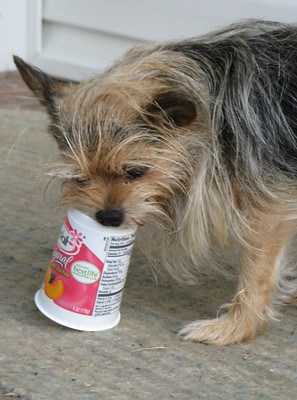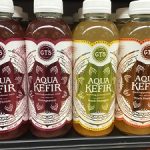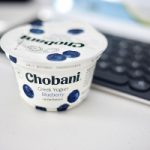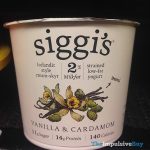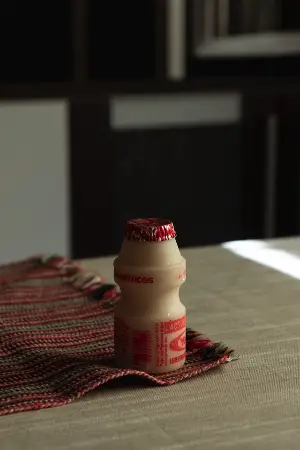I don’t think that you need me to tell you that peach yogurt shouldn’t be a regular part of your dog’s diet!
The good news is that there is nothing toxic in the vast majority of peach yogurts on the market- although any sugar free versions with an ingredient called xylitol are incredibly toxic for your dog and need to be avoided like the plague.
Apart from that, the overwhelming majority of ingredients that you will find in a peach yogurt will neither seriously harm your dog nor benefit them either.
They do have one surprisingly healthy ingredient, which is live bacteria.
But, when all is said and done, the most damage that can be done from your dog eating a 6 oz. or 150 g pot of yogurt is an upset stomach.
And the inconvenience of having to clear it up afterwards is probably enough to make you think again about letting your dog anywhere near your favorite pot of yogurt!
But what exactly is peach yogurt made out of?
Three brands of peach yogurt: Yoplait, Activia, Chobani
To make sure that I give a fairly detailed overview, I am going to look at three brands of peach yogurt- Yoplait, Activia and Chobani.
Now each of these brands probably makes more than one sort of peach yogurt.
But to keep it simple and to stop an article turning into a “thesis” I will only look at one product per manufacturer.
Yoplait peach yogurt
Starting off with Yoplait, I am looking at their “Original Single Serve” peach yogurt.
And here are the ingredients: reduced fat milk, sugar, peaches, modified corn starch, water.
Ingredients that make up less than 1% of the contents include: Corn Starch, Tricalcium Phosphate, Pectin, Natural Flavor, Annatto Extract (for color), Vitamin A Acetate, Vitamin D3
Activia peach yogurt
Moving over to Activia, they make a very popular fat free peach yogurt.
And the ingredients are:
Fat Free Yogurt (Milk), Peach (8%), Carrot and Pumpkin Concentrate, Modified Maize Starch, Thickener (Pectin), Flavouring, Acidity Regulators (Sodium Citrate, Lactic Acid), Sweeteners (Acesulfame K, Sucralose)
Chobani peach yogurt
Finally, Chobani whose peach yogurt is a greek yogurt.
And it contains: milk, peaches, cane sugar, water, fruit pectin, natural flavors, locust bean gum and lemon juice concentrate.
What are the main ingredients in peach yogurt?
Although between the three brands of peach yogurt there are quite a few ingredients, many of them are the same.
Live bacteria (probiotics)
Let’s start with some good news.
All three brands of peach yogurts contain live bacteria or probiotics.
Live bacteria are thought to help dogs (and humans) in a variety of ways.
It is known that they aid digestion and boost the immune system.
Live bacteria are microorganisms that live in a dog’s gut and help to keep it healthy.
Although all of this should be done automatically by a healthy dog, eating live bacteria might help an older dog or a dog who is poorly to recover quicker.
And before we get too excited, there are healthier probiotic yoghurts to feed your dog than peach flavoured ones.
Many natural yogurts (that don’t contain any sweeteners or flavourings) would be just as effective!
Milk
The main ingredient in all of these yogurts is milk and we can be fairly certain that it is cow’s milk.
Milk is OK for most dogs to drink- unless the dog is lactose intolerant.
This is when a dog struggles to digest the main protein in milk, which is lactose.
No one knows quite how many dogs suffer from lactose intolerance.
However symptoms can include diarrhea and bloating.
Even fat free milk contains lactose.
Peaches
Peach flesh is perfectly safe for a dog to eat and like all fruits they will contain lots of healthy vitamins and minerals.
It could be that you have heard that peaches can poison dogs.
It is the pit or stone that contains cyanide and not the flesh.
Modified corn/ maize starch
OK now we are moving onto some of the more undesirable ingredients.
But just because they are indesirable, it doesn’t mean that they are toxic for your dog.
Made from corn, the starch is modified either by heat or treating it with some sort of acid in order to thicken it.
It is then added to lots of foods to help thicken them.
Corn is a widely used ingredient in dry dog food- read the ingredients on your bag of food and see if you can find it.
Pectin
This is another type of starch, which although won’t poison your dog, it isn’t exactly the most healthy of ingredients.
It comes from plants and it is most widely used in things like jellies because it gives them that semi solid structure.
And that is why it is added to yogurts- to help thicken them.
Locust bean gum
Another “plant extract” added to food to thicken it!
Sugar
We all know what sugar is, how widely it is used in foods and how badly it can affect our health.
In terms of do’s it has five side effects, which can include cavities, obesity and diabetes.
The chart below shows how much sugar is in each of these yogurts.
| Yoplait | Activia | Chobani | |
| Sugar | 11% | 7.2% | 9.3% |
The Yoplait yogurt comes out highest with an 11% sugar content.
Second is the Chobani peach yogurt with 9.3% and finally the Activia is 7.3% sugar.
That is a lot of sugar.
In the small quantities found in peach yogurt, your dog won’t suffer any real harm.
Apart from developing a sweet tooth and wanting to come back for more!
The Chobani yogurt lists cane sugar as an ingredient.
This can be a bit misleading because some people believe that cane sugar is healthier than processed sugar.
But to be honest, there is very little difference between the two!
Salt
If you are a bit concerned because up to this point I have mentioned salt, then don’t panic because now I am.
And it is good news- most of these yoghurts have very little salt content.
Much less than 1%.
Which is good news for your dog.
To see how much, take a look at my chart.
| 100 g serving | Yoplait | Activia | Chobani |
| Sodium (Salt) | .060 g | .25 g | .055 g |
The Yoplait and Chobani yogurts have much much less than 1% of salt in them.
In the next section, I want to sound a cautionary note..
There is one ingredient, which might be in some varieties of peach yogurt, that could kill your dog.
The dangers of xylitol
Xylitol is a sugar substitute.
It is used in some sugar free or low sugar foods because whilst it has the same sweetness as refined sugar, it has less than half of the calories.
Now I have spent about 10 minutes searching on the Internet for sugar free peach yogurts to see if I can find any that contain xylitol.
And the good news is that I can’t.
Other sweeteners are used such as aspartame and Acesulfame K but these sweeteners aren’t poisonous to dogs.
But it doesn’t mean that it isn’t being used at all.
And so please just check the list of ingredients on the side of your peach yogurt!
How does xylitol affect your dog?
When a dog eats xylitol it is quickly absorbed into the bloodstream.
It then wrongly triggers the pancreas to release a huge dose of insulin, which results in a dog’s sugar level plummeting to dangerously low levels.
Depending on the amount of xylitol which has been ingested will affect how quickly your dog will show signs of being poisoned.
But the effects can usually be seen within the hour.
The symptoms of xylitol poisoning
If the very worst happens and your dog eats some yogurt that contains xylitol, you need to take them to the vet immediately.
You can’t mess around searching for any home remedy- time is of the essence
The symptoms that you are looking out for include vomiting and diarrhea at the milder end of the spectrum or lack of balance and seizures in the most extreme cases.
Should I feed my dog natural yogurt instead?
As I mentioned earlier, natural yogurt that contains live bacteria could be an excellent product to use if you want to improve the digestive health of your dog.
It is free from many of the flavours and sweeteners used in flavoured yogurts such as peach yogurts and because of that it is a healthier choice for your dog.
It is not just yogurt that contains live bacteria- other foods do as well.
But they tend to be a bit “special”. I’m talking about foods like sauerkraut.
A more readily available food that contains live cultures are pickles or gherkins.
Add a jar of those into your dog medicine cabinet!

